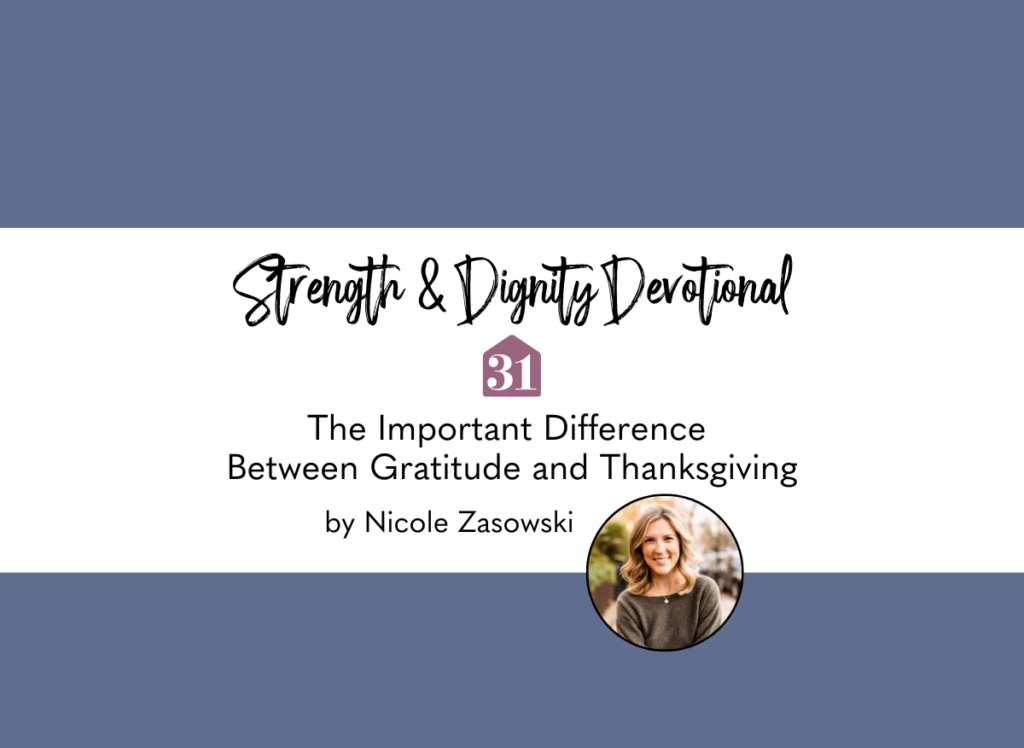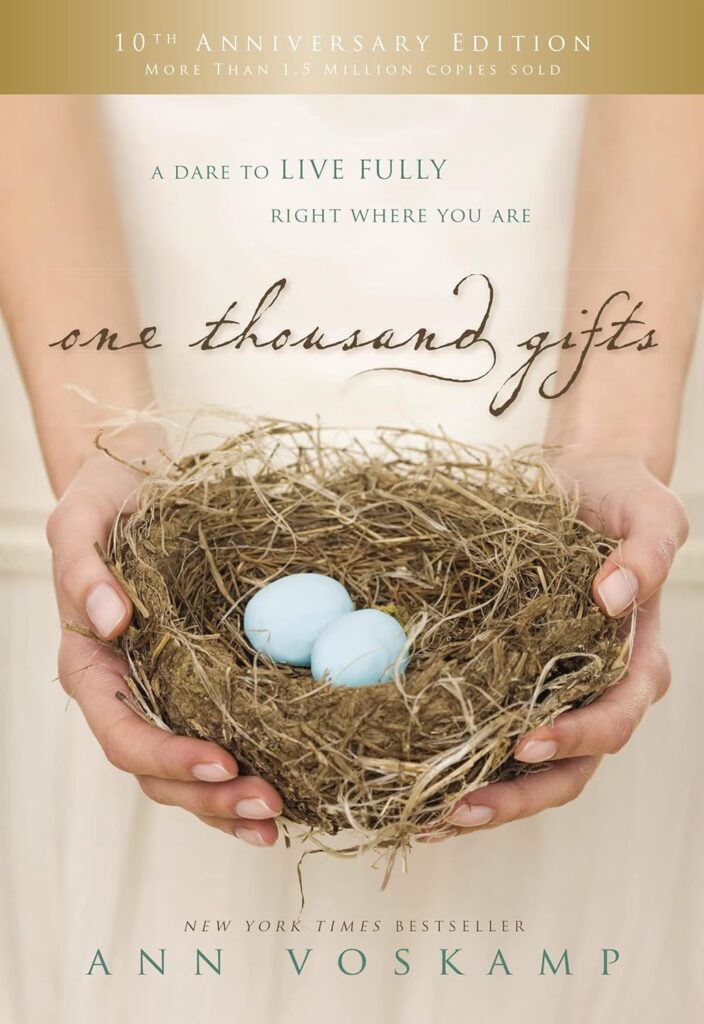The Important Difference Between Gratitude and Thanksgiving
Gratitude has become a common topic of conversation in our culture in recent years. We often talk about gratitude’s power to increase our joy and improve our well-being.
And it seems like we can’t walk into a gift shop or boutique without seeing a gratitude journal or a decorative gratitude jar creatively displayed on a shelf. I used to use the words and concepts of gratitude and thanksgiving interchangeably, but I’ve learned that there’s an important difference between the two…and it’s made all the difference for me!

The story we find in Luke 17:11-19 shows us this difference.
In this passage, we find ten men who suffered from leprosy standing together on the side of the road. Their shared misery brought this unlikely group together. Their identity as outcasts of society was stronger than their cultural or religious affiliations. They were human beings with feelings and opinions, gifts and talents, but their disease defined their identity as they were forced to shout “Unclean! Unclean!” as they hobbled through the streets. From their place at the bottom of society (especially the Samaritan) they had nothing left to lose in shouting something different to Jesus when they caught sight of Him.
“Have mercy on us!” they cried (v. 13 ESV). As a God who sees our pain, Jesus saw them and had compassion on them and instructed the group to go to see the priest, which is traditionally what one did after having been healed.
The entire group made their way toward the temple, and on their way, they recognized their own healing in their friends. Faces were restored to their original form, bodies were repaired, and their skin became smooth and blemish free, and therefore, their social and religious health was instantly restored.
All ten men demonstrated their faith and were physically cured. All ten men celebrated the outcome of their ask. We can assume that all ten men felt grateful. But only the Samaritan returned to thank Jesus for the healing. The other nine men celebrated their physical healing and returned to lives they had known and loved. But the Samaritan returned to Jesus, threw himself at Jesus’ feet, thanked Him, and gave glory to God.
Healer and Eternal Hope
In returning to Jesus, we can assume that the Samaritan not only celebrated his physical healing but that his bodily restoration is also an inwardly transformative experience for him. The Samaritan sees Jesus as not simply his Healer but also his Hope.
Jesus responded by asking about the other nine. “Were not all ten healed?” (v. 17 The Message). And turning to the Samaritan, He said, “Your faith has healed and saved you” (v. 19 The Message). The ten lepers’ obedience had cured them physically. But the Samaritan’s faith had made him well in body and soul. Giving glory to God had made him whole and took his healing beyond the boundaries of his body to include a spiritual healing. And the Samaritan expressed his gratitude through thanksgiving to Jesus.
Often, I assume that my inward emotional experience of gratitude offers the same benefit as outwardly expressing my appreciation to God through the practice of thanksgiving. But Jesus clearly distinguishes between the two in His conversation with the Samaritan. In this exchange we understand that thanksgiving is the outward expression of the gratitude we feel in our hearts.
It’s important that we recognize that Jesus’ question is not merely a bid for our praise. No, thanksgiving is the avenue we have been given to celebrate our joy with Jesus— to celebrate the gift with the giver of all good gifts. Practicing thanksgiving reminds us that gifts always come from outside ourselves. And perhaps most importantly, thanksgiving bonds us with God—the source of all joy.

Neuroscience research confirms the benefits of thanksgiving in the way that God designed our brains. Research says that when we express our gratitude out loud through thanksgiving, either to God in our prayers or to other people He has placed in our lives, we will experience twice the joy we would have experienced had we simply felt grateful in our hearts.
Enjoying good news is a grace. But what a treasure we have in the invitation to celebrate with our heavenly Father through thanksgiving. The practice of thanksgiving reminds us that God is not only present in our pain but also present at the party. God is near and His touch is tender as He walks with us over the uneven plains of longing and uncertainty and across the perilous terrain of heartbreak and sorrow. But when we reach ground that is soft underfoot—seasons characterized by breakthrough and good news—He does not let go. Our God is not only available to us in our struggle but also longs to join us in our joy. Expressing our gratitude out loud through thanksgiving is how we celebrate with God.
Let’s accept the invitation extended to us in the story from Luke 17. Let’s express our gratitude to God out loud through the practice of thanksgiving. In doing so, we will double our joy and celebrate with a God who longs to join us in our joy.
In Your Life
Where do you see yourself in the story of the ten lepers from Luke 17?
How does it shape your ideas about gratitude to consider thankfulness as a means of celebration with God?
We Recommend
What If It’s Wonderful? By: Nicole Zasowski — Joy can feel risky. When you’ve experienced pain of any kind, it can feel safer not to embrace joy at all than to hold something that might break. Regardless of how different our stories might be, we all know what it’s like to feel afraid to dream because we might be disappointed, afraid to hope because we might be heartbroken, or afraid to try because we might fail. If you ever feel like joy is out of reach, you’re not alone. Thankfully, the Bible paints a different picture—one that gives us the courage to hold joy regardless of our circumstances. In What If It’s Wonderful, marriage and family therapist Nicole Zasowski shows us how the practice of celebration is what sustains our hope in seasons of both joy and pain.

One Thousand Gifts By: Ann Voskamp — In One Thousand Gifts, Ann Voskamp invites you to discover a way of seeing that opens your eyes to ordinary amazing grace, a way of living that is fully alive, and a way of becoming present to God that brings deep and lasting joy. It’s only in the expression of gratitude for the life we already have, we discover the life we’ve always wanted…a life we can take, give thanks for, and break for others. Come to feel and know the impossible right down in your bones: you are wildly loved by God.

Let’s Connect
Nicole Zasowski’s books From Lost to Found and What If It’s Wonderful? can be found anywhere books are sold. Nicole would love to connect with you through her website or on Instagram at @nicolezasowski.
